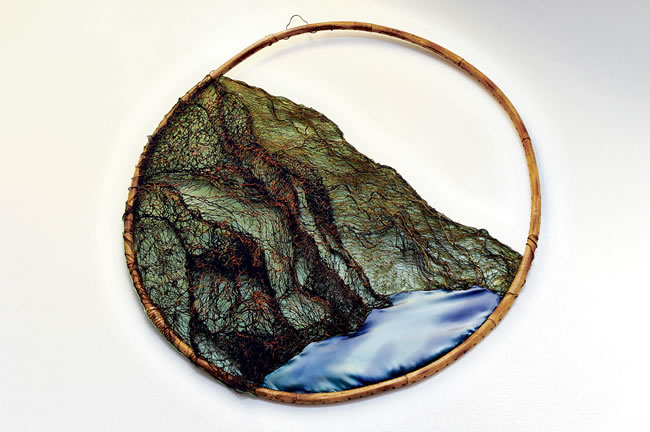When Art Trumps Politics
Mona Lisa doesn’t really do it for me (gasp), but I now understand the thrill of a great piece of artwork. There’s a batik of a Polynesian woman hanging in state Sen. Brickwood Galuteria’s office at the state Capitol. Maybe it’s the fluid, lounging curves of the woman, the simplicity of the presentation or the attractive shades of brick red, but this woman in red is mesmerizing.
Artwork is probably the last thing that comes to mind when you think of the Capitol, but its rooms are laden with statues, carvings, textiles, numerous handcrafted works and paintings by top artists including Satoru Abe, Tadashi Sato, Isami Doi and Jean Charlot.
Many of the lawmakers and artists will be present March 2 when the Capitol opens to the public for viewing of the art, much of it belonging to the 5,600-piece collection owned by the State Foundation on Culture and the Arts, and some from private collections. I recently got a sneak peek of several rooms, but 50 will be on show that night, along with a couple of films on the artwork, plus entertainment by a student quartet and a general flurry of excitement throughout the building.
The characters in the offices tend to be as intriguing as the artwork. Sen. J Kalani English of Hana, Maui, dives passionately into the background of the artifacts draping his quarters. He personally acquired many of them in Polynesia and the Pacific Islands -a carved wood storyboard from Palau, a Marshallese navigation map, a ceremonial deity from Tahiti, poi grinders (one a gift from a Rurutu princess) and a peace-keeping basket carried by the men of Yap. To not carry one is to provoke war.
Next, meet Rep. Tom Brower, quirky and artistic and drawn to the modern. Origami cranes hang from his ceiling. Magazine cutouts cluster his walls, and desk panels feature bold blackand-white patterns. Most intriguing is his collection of midcentury modern chairs (“ghost chairs” from Paris, an aluminum chair with a World War II background, a replica of the first chair made from a single mold) and his own artwork with its tongue-in-cheek presentation. His staff says he’s also a rapper and poet.
Rep. Derek Kawakami’s office sports an intimate flair playful pictures of him and his wife mugging for the lens of their 7-year-old daughter. On his desk is his grandfather’s memoir of his journey from Japan to Hawaii in the 1800s, his struggle to raise a family on the plantation and his eventual creation of one of Kauai’s most successful grocery stores.
Then there’s public access coordinator Suzanne Marinelli’s office littered (if the word fits?) with reclaimed art. She has gathered and fashioned thrift shop shawls, scrap yard metals, branches, buttons, wire you-name-it into baskets and structures pleasant to the eye and the imagination.
A room apart is the stately and majestic Governor’s office with towering walls that bear the glorious shine that only belongs to koa: giant, pure koa walls!
As you cruise through the rooms, file cards label State Foundation pieces, along with detailed information. Eye your faves, but my heart belongs to that woman in red.
the TICKET stub
When: First Friday, March 2, 5-7 p.m.
Where: State Capitol
Cost: Free
More Info: 587-7242
ALSO SHOWING
Prized Pottery
Artists’ houses: By necessity, there’s a mess of creativity flooding their rooms. Local ceramic artist Steve Murin, self-labeled “The Mad Potter of Palolo,” was no exception. When he passed away earlier this year, he left a treasure of media from some of the modern world’s most renowned artists. Among the gems are representations of children, plump and attractively rounded, the distinct style of Jean Charlot, a close friend of Murin’s. Some Pegge Hoppers riddle the collection, older ones that belie the look of her more known work. There are stacks of posters, photographs, etchings, paintings, books many original works, together a priceless cache.
The Mad Potter also left his own impressive collection of pottery, an entire roomful, stacked on tables and shelves in myriad shapes and earthen hues. There’s one of his famous chess sets, sculptures, bowls, plates, mugs, vases … all made in a wood-fired bread oven in his backyard, hence his humorous moniker. He styled his pieces after Japanese folk craft with an emphasis on form over glaze and color.
Loving tributes to the literary world are etched into many of his pieces. Under a crimson bowl with its cream interior is scribed: “Read to teach, read to learn, read to enjoy … but read.” Another large bowl bears the words: “A child’s best friend is a Book, and he should have many Friends!” On the bottom of a square platter he quips: “Being square has little to do with shape.”
The public is invited to hunt through the works at a March 3 estate ceramic sale from 10 a.m. to 4 p.m. at Maryknoll High School (1402 Punahou St.) in the art room. For more information, call Kay Inglis at 753-1574.






